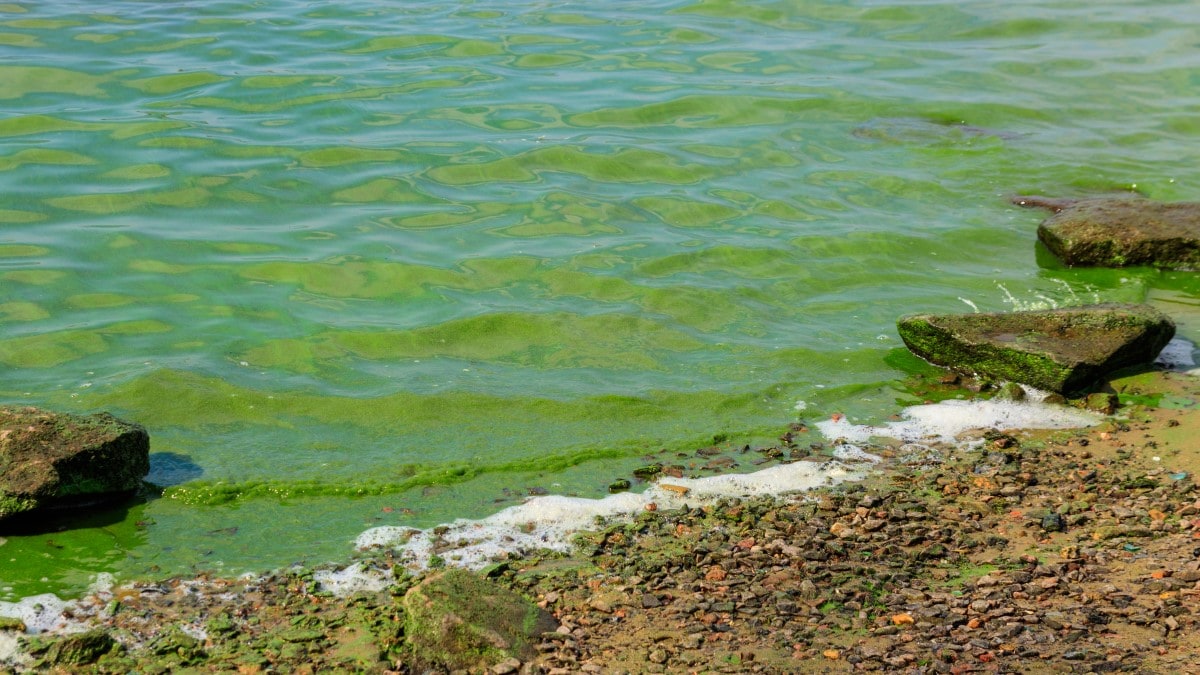Key points
- Check for and follow swimming, fishing, and shellfish advisories before visiting lakes, oceans, and other bodies of water.
- If water looks or smells bad, stay out and keep kids, pets, and livestock away.
- Follow advice from officials if a harmful algal bloom is in your tap water supply.

Overview
Harmful algal blooms can make water look or smell bad. They can also make toxins (poisons), which are sometimes in water even when you cannot see any signs of a bloom.
Avoid getting sick by following advisories and staying out of water with signs of a harmful algal bloom. Keep kids, pets, and livestock away from harmful algal blooms too.

Exposure
You or your animals can get sick from a harmful algal bloom if you:
- Go in or near water contaminated by a harmful algal bloom
- Swallow contaminated water
- Eat contaminated shellfish or fish
- Use contaminated blue-green algae dietary supplements
Prevention steps and strategies
Visiting lakes, oceans, or other bodies of water
Check for swimming advisories
Check for swimming advisories before visiting lakes, oceans, or other bodies of water. Follow advisories to avoid getting sick.
Local or state governments often post advisories on their websites, near the water, or both.

Stay out of water that looks or smells bad
Avoid fishing, swimming, boating, or playing water sports in water with signs of a harmful algal bloom.
Stay out of water that:
- Smells bad
- Looks discolored
- Has foam, scum, mats of algae, or paint-like streaks on the surface
- Has dead fish or other animals washed up on its shore
Rinse off
If you do go in or touch water that may have a harmful algal bloom, rinse off immediately after. Use tap water from a sink, shower, hose, or outdoor spigot.
Fishing or collecting shellfish
Check for and follow local shellfish and fishing advisories before eating any fish or shellfish you catch or collect yourself. Find advisories on your state's website or posted near the water.
Harmful algal bloom toxins in fish or shellfish have no taste or smell. Cooking or preserving food does not remove toxins. You cannot tell if the seafood is safe just by looking at, smelling, or tasting it.
Your state government is required to control for toxins in areas where harmful algal blooms are likely to grow and toxins could build up in shellfish. This can include:
- Routine monitoring for toxic algae or shellfish
- Testing shellfish for toxins before or after harvesting
If levels of toxins are unsafe, state authorities will close the area for shellfish harvesting until shellfish are safe to eat.
Tap water
Follow drinking water advisories
Follow advice from local officials if they tell you there is cyanobacteria (blue-green algae) or toxins in your tap water supply.
Do not boil water containing toxins
Contact officials with concerns
Harmful algal blooms of cyanobacteria sometimes grow in reservoirs or other water bodies that supply tap water. Although many water treatment plants can remove the toxins cyanobacteria make, tap water can be contaminated in certain situations. Cyanobacteria can also make substances that are not harmful but change the taste or smell of tap water.
If you are concerned about your tap water, contact your utility or health department. Consider using bottled water for drinking and cooking until the problem is fixed.
Filling pools
Do not fill pools with water directly from lakes, rivers, or ponds. The water could contain harmful algal bloom toxins or unsafe levels of germs.
Preventing harmful algal bloom growth
Use only the recommended amount of fertilizers on your farm, yard, and garden. This will reduce the amount of nutrients running off into nearby water bodies. Nutrients in the water can help harmful algal blooms grow.
Maintain your septic system to keep wastewater from getting into nearby bodies of water. Wastewater is full of nutrients that can feed harmful algal blooms.
Learn more about factors that can help harmful algal blooms grow.
Traveling
When traveling outside the United States, avoid eating large reef fish such as barracuda, grouper, or amberjack. Especially avoid eating the head, gut, liver, or roe (eggs). Large reef fish may contain the harmful algal bloom toxin that causes ciguatera fish poisoning. Seafood sold in stores or restaurants in the U.S. must meet federal safety standards. However, not all countries have similar standards.
See the U.S. Food and Drug Administration's (FDA) Fish and Fishery Products Hazards and Controls Guidance for a list of reef fish that are more likely to have unsafe levels of toxins.
Prevention in animals
Keep animals out
Protect your pets and livestock by keeping them away from water with signs of a harmful algal bloom. Animals are more likely than people to get sick from harmful algal blooms. In part, this is because they will drink water even when it looks or smells bad, and eat algae or dead fish on the shore.
Rinse off animals
If your animals do go in water that may have a harmful algal bloom, rinse them off immediately after. Use tap water from a sink, shower, hose, or outdoor spigot.
Do not let them lick their fur before you rinse them. Animals can have harmful algae, cyanobacteria, or toxins on their fur if they were in water with a harmful algal bloom.
Get help immediately for sick animals
If your pets or livestock seem sick after going in or near water, call a veterinarian right away. Animals can get very sick or die within hours of swallowing some types of harmful algal bloom toxins.
If you have symptoms
If you think you got sick from a harmful algal bloom, talk to your healthcare provider or call your local Poison Center at 1-800-222-1222.
Although there are no specific treatments for illnesses caused by harmful algal booms, a healthcare provider can help relieve your symptoms.
Poison Center specialists can provide information about illnesses caused by harmful algal blooms.
Reporting
Water concerns
Contact your local government if you are worried about the look or smell of a lake, ocean, or other water body. Report your concerns to an agency such as your:
- Health department
- Environmental protection department
- Local park authority
If you have concerns about the look, smell, or taste of your tap water, contact your water utility or health department.
Illnesses
Report illnesses that you think were caused by a harmful algal bloom to your health department. This includes illnesses or symptoms in people or animals.
Reporting helps your health department better understand illnesses and prevent more illnesses.
Help collect data
If you want to help track harmful algal blooms, check if there is a citizen science program in your area. For example, some states use tools like the BloomWatch app, the CyAN app, or the National Phytoplankton Monitoring Network.

